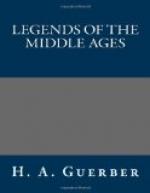[Sidenote: An earlier version of the story.] According to an earlier version of the story, Esclarmonde, whom the pirates intended to convey to the court of her uncle, Yvoirin of Montbrand, was wrecked near the palace of Galafre, King of Tunis, who respected her vow of chastity but obstinately refused to give her up to her uncle when he claimed her. Huon, delivered from his fetters on the island, was borne by Malebron, Oberon’s servant, to Yvoirin’s court, where he immediately offered himself as champion to defy Galafre and win back his beloved wife at the point of the sword. No sooner did Huon appear in martial array at Tunis than Galafre selected Sherasmin (who had also been shipwrecked off his coast, and had thus become his slave) as his champion. Huon and Sherasmin met, but, recognizing each other after a few moments’ struggle, they suddenly embraced, and, joining forces, slew the pagans and carried off Esclarmonde and Fatima. They embarked upon a swift sailing vessel, and soon arrived at Rome, where Huon related his adventures to the Pope, who gave him his blessing.
As they were on their way to Charlemagne’s court, Girard, a knight who had taken possession of Huon’s estates, stole the golden casket from Sherasmin, and sent Huon and Esclarmonde in chains to Bordeaux. Then, going to court, he informed Charlemagne that although Huon had failed in his quest, he had dared to return to France. Charlemagne, whose anger had not yet cooled, proceeded to Bordeaux, tried Huon, and condemned him to death. But just as the knight was about to perish, Oberon appeared, bound the emperor and Girard fast, and only consented to restore them to freedom when Charlemagne promised to reinstate Huon.
Oberon then produced the missing casket, revealed Girard’s treachery, and, after seeing him punished, bore Huon and Esclarmonde off to fairyland. Huon eventually became ruler of this realm in Oberon’s stead; and his daughter, Claretie, whose equally marvelous adventures are told at great length in another, but far less celebrated, chanson de geste, is represented as the ancestress of all the Capetian kings of France.
CHAPTER XI.
TITUREL AND THE HOLY GRAIL.
[Sidenote: Origin of the legend.] The most mystical and spiritual of all the romances of chivalry is doubtless the legend of the Holy Grail. Rooted in the mythology of all primitive races is the belief in a land of peace and happiness, a sort of earthly paradise, once possessed by man, but now lost, and only to be attained again by the virtuous. The legend of the Holy Grail, which some authorities declare was first known in Europe by the Moors, and christianized by the Spaniards, was soon introduced into France, where Robert de Borron and Chrestien de Troyes wrote lengthy poems about it. Other writers took up the same theme, among them Walter Map, Archdeacon of Oxford, who connected it with the Arthurian legends. It soon became known in Germany, where, in the hands of Gottfried von Strassburg, and especially of Wolfram von Eschenbach, it assumed its most perfect and popular form. The “Parzival” of Eschenbach also forms the basis of a recent work, the much-discussed last opera of the great German composer, Wagner.[1] [Footnote 1: See Guerber’s Stories of the Wagner Opera.]




